
We determined the impact of moderate maternal nutrient restriction (MNR) in guinea pigs with fetal growth restriction (FGR) on offspring body and organ weights, hypothesizing that FGR-MNR animals will show catch-up growth but with organ-specific differences. Guinea pig sows were fed ad libitum (Control) or 70% of the control diet from 4 weeks preconception, switching to 90% at midpregnancy (MNR). Control newborns >95 g [appropriate for gestational age (AGA); n = 37] and MNR newborns <85 g (FGR; n = 37) were monitored until neonatal (~25 days) or adult (~110 days) necropsy. Birth weights and body/organ weights at necropsy were used to calculate absolute and fractional growth rates (FRs). FGR-MNR birth weights were decreased ~32% compared with the AGA-Controls. FGR-MNR neonatal whole body FRs were increased ~36% compared with Controls indicating catch-up growth, with values negatively correlated to birth weights indicating the degree of FGR leads to greater catch-up growth. However, the increase in organ FRs in the FGR-MNR neonates compared with Controls was variable, being similar for the brain and kidneys indicating comparable catch-up growth to that of the whole body and twofold increased for the liver but negligible for the heart indicating markedly increased and absent catch-up growth, respectively. While FGR-MNR body and organ weights were unchanged from the AGA-Controls by adulthood, whole body growth rates were increased. These findings confirm early catch-up growth in FGR-MNR guinea pigs but with organ-specific differences and enhanced growth rates by adulthood, which are likely to have implications for structural alterations and disease risk in later life.
Available at: http://works.bepress.com/timothy-regnault/22/
